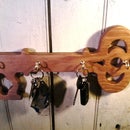Introduction: Jigsaw to Scroll Saw Conversion
In the infancy of my woodshop, back around 2010, I realized that I badly needed a scroll saw, but sorely lacked the funds. Using what I had available to me at the time, I was able to create a fixture that firmly secured my Black and Decker jigsaw, essentially turning it into a functional and versatile scoll saw. This is still one of my primary tools still utilized in my shop, and I've churned out some high quality projects with it.
What you will need:
- A jig saw (obviously)
- A hand saw or circular saw
- Scrap lumber that best suits your needs
- A Dremel Trio (not necessary at all, but makes routing the hole a bit easier)
- Wood screws
- A drill press or drill gun, along with assorted drill bits
- Some sandpaper (not critical, but no one want's splinters everywhere).
Step 1: Make the Mounting Surface and Saw Blade Hole
I found a nice 0.5" piece of plywood and cut it to approximately 8" X 12" with my circular saw.
Using my jigsaw to gauge the relative location I wanted to mount it in, I marked where the saw blade would stick out from the mounting surface, and gave my self some clearance, let's say no less than 0.375" in either direction about the blade.
I then used my Dremel Trio to create a rectangular hole that fit into my markings. Alternatively, this feature could be made by drilling a 5/16" hole in each corner of the rectangle, and then using my jig saw to cut between the four holes.
Either way works fine, just depends on the tools you have on hand and how good you are at using them.
Step 2: Drill Out the Mounting Holes and Counterbores
I found two sets of 1/4"-20 nuts and bolts that seemed perfect for the job. Don't forget to check the mounting hole size on your jig saw, but I'm pretty sure the standard is about a 0.25" clearance hole.
I drilled a starter hole with the smallest drill bit, drilled through with the middle drill bit (0.25"), and then drilled 0.25" deep with the largest drill bit, so that the bolt head would be recessed below the top surface of the mounting board. Again, use whatever dimensions you see fit that correspond relative to the hardware you want to use.
Step 3: Cut Out the Legs
It goes without saying that the legs of the stand should be a bit taller than the height of the jig saw itself, just so that the thing can fit inside comfortably.
I used 2"X6" board, cut to approximately 9" tall with my circular saw.
Step 4: Attach the Legs to the Mounting Surface
Now that the legs are cut out, you need to attach them to the mounting surface. Because I didn't know if I would need to take this thing apart for any reason in the future, I stuck to wood screws and didn't use any glue at all.
I clamped the legs to the mounting board, drilled 0.125" starter holes, and screws the three pieces together as shown, all pretty straightforward. No more than two wood screws per leg, (2" long) should do the trick nicely.
Step 5: Cut Out the Base and Attach It to the Legs
I cut the base to an arbitrary dimension out of 0.375" plywood. Since I wanted this stand to be moved around the shop (because I had very little space back then), I made sure to oversize the base, which allowed to clamp it down on either side to any table top.
Once I had it positioned where I wanted it, I traced the layout of the legs onto the base, clamped everything together, and followed the procedure from the previous step to screw everything together.
Step 6: Attach the Jig Saw to the Mounting Board
Then I simply positioned the jigsaw in place, slid the screws through, and tightened everything up with pliers and a screwdriver.
As an afterthought, I added in some washers to better hold the jig saw in place.
Step 7: Finished!
There you have it!
It's not the prettiest build, but like I've said before, I have this setup still running smoothly in my shop almost four years later.
Clamping the whole thing down somehow is important, please don't hurt yourself by forgetting that.
In retrospect, building some sort of guard or safety features would have been a bit smarter, but I've never hurt myself with this setup, so oh well.
Hope you like it!

Participated in the
Woodworking Contest













